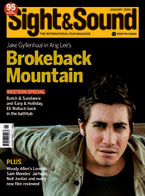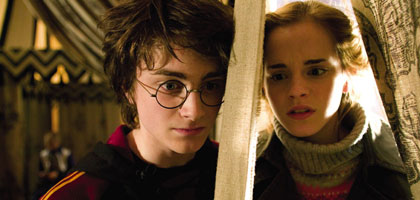Primary navigation

UK/USA 2005

Reviewed by Jonathan Barnes
Our synopses give away the plot in full, including surprise twists.
Junior wizard Harry Potter dreams of a snake and his nemesis Lord Voldemort. He attends the Quidditch world cup. The event is attacked by Death Eaters, Voldemort's followers. Harry begins his fourth year at Hogwarts, a school for wizards, where he is reunited with friends Ron Weasley and Hermione Granger. There is a new teacher - Mad-Eye Moody. Hogwarts is hosting the Tri-Wizard Tournament, a magic championship consisting of three tasks. Delegations from two other schools - Durmstrang and Beaubaton - arrive. Barty Crouch, an official from the Ministry of Magic, is there to oversee events. The goblet of fire - a magic cup - chooses a champion to represent each school. In addition to Viktor Krum from Durmstrang, Fleur Delacour from Beaubatons and Hogwarts' Cedric Diggory, the goblet produces Harry's name. The first task is to retrieve an egg from a dragon's nest. All the contestants succeed.
Hogwarts' Yule ball arrives. Harry and Ron have difficulty getting dates. Harry asks fellow student Cho Chang but is turned down. Hermione goes with Krum. The second task in the Tri-Wizard Tournament is to rescue captive friends from the merpeople beneath the school lake. Delacour fails and Harry rescues her sister as well as Ron. Barty Crouch is found dead. The final task is to reach the centre of a maze. Harry and Cedric succeed and are transported to a graveyard. Harry is bound and cut by Wormtail, Voldemort's servant. Wormtail revives Voldemort, who kills Cedric then battles Harry. The ghosts of Harry's parents save him. Harry returns to the school. He discovers that Moody is Barty Crouch's son in disguise; loyal to Voldemort, he has manipulated events and murdered his father.
At the end of the year, Harry and his friends face an uncertain future.
Opening with a vision of near-Biblical evil and sputtering to a finish amid flurries of CGI and overacting, Harry Potter and the Goblet of Fire never quite makes good on its promise. The fourth in a franchise that has almost succeeded in producing an instalment a year, it shares with its immediate predecessor, The Prisoner of Azkaban, a more distinctive weft than those inaugural episodes (The Philosopher's Stone and The Chamber of Secrets) ploddingly directed by Hollywood journeyman Chris Columbus. The perpetrator of Home Alone and Mrs Doubtfire, Columbus was a safe choice to midwife a family-friendly franchise that the studio must always have hoped would prove indecently lucrative. However, as the series grows in confidence so has its readiness to take risks. Alfonso Cuarón, best known for Y tu mamá también, was a left-field candidate to helm The Prisoner of Azkaban, and Mike Newell, whose CV pinballs from the froth of Four Weddings and a Funeral to the grit of Donnie Brasco, is a no less unexpected choice for the latest chapter.
Newell falters in the action sequences (Harry's protracted sparring with a dragon never thrills as it should, the Quidditch games seem as blurred and baffling as ever, and the climactic showdown ambles by perfunctorily), but shines during the character moments and in his sensitive charting of the film's emotional trajectory. Cuarón leant his movie a wistful, melancholic quality befitting a story that dealt with the end of childhood and the evanescence of innocence. But in granting The Goblet of Fire an earthier real-world tone, Newell has crafted a parable about the pains and pangs of adolescence. In doing so, he has made the most grown-up Potter yet.
Throughout, there is a sense of darkness pressing in from the outside, ever present but unseen, exterior menace, interior confusion. The public-school cosiness ebbs away: Hogwarts no longer seems a cheerful haven, and its headmaster Dumbledore appears not as an all-wise paterfamilias but an old man scared of the future. As well as depicting the stuttering beginnings of first love in Harry's maladroit wooing of fellow student Cho Chang, Newell's film captures the queasy recognition that accompanies the earliest stirrings of puberty, that parents are flawed, that home is not necessarily safe, that the world at large is unjust.
For all this, The Goblet of Fire never feels anything other than a single thread of a larger narrative: plot strands are set up for later instalments, favourite characters are given nothing to do and a satisfying confrontation with the hero's nemesis deferred to some future encounter. At least Newell's film is less in thrall to the source material than the first two movies in the series, which followed J.K. Rowling's books like a route map. But The Goblet of Fire never threatens to displace the literary originals as Peter Jackson's Tolkien triptych vibrantly recast The Lord of the Rings. In truth, the Potter movies are mere adjuncts to the books, which is inevitable unless an imagination as ferociously unruly as Rowling's own is to be handed the series' reins.